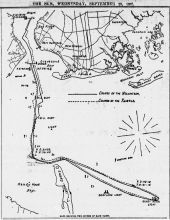 The weather at this time was exceedingly unpromising. The sky was overcast by a heavy grayish mist that hung like smoke and tilled the lungs. The sun peered through it faintly, a round yellow ball in the dim sky. Such wind as there was came from the north by west. It was a weak and wavering wind that had no more backbone than a wet umbrella cover. The Bay was shrouded in the mist, and here and there tugs slid through the haze like the ghosts of so many dwarfs. The sails of vessels trying to make their way about the Bay flapped idly and flags hung lifeless in the dull morning atmosphere. Everyone said there would be no race except that dogged old salt who always prophesies that the wind will come from the Antarctic Ocean. “The wind is never lost but it's found in the south," is his proverb, and once in a while it comes true, as it did yesterday. The weather at this time was exceedingly unpromising. The sky was overcast by a heavy grayish mist that hung like smoke and tilled the lungs. The sun peered through it faintly, a round yellow ball in the dim sky. Such wind as there was came from the north by west. It was a weak and wavering wind that had no more backbone than a wet umbrella cover. The Bay was shrouded in the mist, and here and there tugs slid through the haze like the ghosts of so many dwarfs. The sails of vessels trying to make their way about the Bay flapped idly and flags hung lifeless in the dull morning atmosphere. Everyone said there would be no race except that dogged old salt who always prophesies that the wind will come from the Antarctic Ocean. “The wind is never lost but it's found in the south," is his proverb, and once in a while it comes true, as it did yesterday.
WAITING FOR A BREEZE.
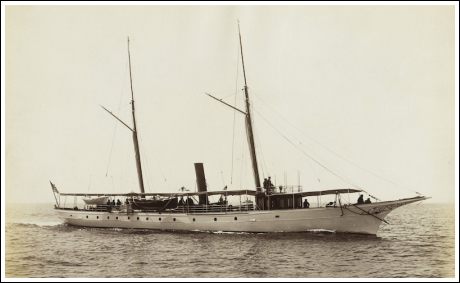
When the Talisman reached Bay Ridge she found a fine fleet at anchor waiting for the wind. The tide was on the last of the ebb, and there was some hope that a breeze would come in with the flood. The Volunteer loomed up through the gray morning like a Boston spectre. She had her club topsail and mainsail set and her jib up in stops, all ready for business. The Talisman ran alongside and found Gen. Paine, clad in a pea jacket and straw hat, peering around through a telescope to study the weather. E. A. Willard was beside him, in a white flannel suit, while Mr. Wylie, of the Clyde Yacht Club, the Thistle's representative on board, was gorgeous in a yellow and black striped blazer.  Mr. Burgess wore a yachting cap well down over his eyes and a blue jersey, as he leaned against the Volunteer’s wheel, and Capt. Haff patted various ropes affectionately as he moved confidently about the deck. Mr. Burgess wore a yachting cap well down over his eyes and a blue jersey, as he leaned against the Volunteer’s wheel, and Capt. Haff patted various ropes affectionately as he moved confidently about the deck.
The Thistle about this time was descried getting under way from her anchorage off Tompkinsville. She was under mainsail, club topsail, foresail, jib, and baby jib topsail. There was a very faint bit of air to fan her along, but she contrived to run up to a position just above the starring point, where she dropped her kedge and lay at anchor, her company being kept busy answering salutes. Mr. Bell was clad in his white flannel yachting costume, and he looked as happy as a jolly sea dog who had faith in the graceful fabric under him ought to look.
As soon as Gen. Paine saw that the Thistle was under way he bethought himself that it was time for Boston to be up and doing. Seeing the tug Harry Russell near at hand, with a Boston photographer in charge, Mr. Burgess hailed her and requested her to come alongside. She did so, and a line from the Volunteer’s bow was passed to her. She towed the steel sloop out from her anchorage amid cheers and tooting of whistles which told plainly which way the popular pulse was beating. The Volunteer was towed to a position a little to the north and west of the Thistle, and there she, too, let go her kedge and lay at anchor to wait for a breeze.

The Electra had, meanwhile, taken her place a little over a quarter of a mile west of Buoy 18, between which and herself was the imaginary line in be crossed by the racers in starting. The course yesterday was the regatta course of the New-York Yacht Club. This is from Buoy 18, off 0wl‘s Head, below Bay Ridge, to and around Buoys 10 and 8½, on the west end of Flynn’s Knell, inside Sandy Hook, thence past Sandy Hook Point to and around Sandy Hook Lightship, seven miles outside the Hook, rounding it and keeping it on the starboard hand, and thence back over the same course to a finish at Buoy 15, which is below the Narrows.
The starting signal would have been given soon after 10:30 o’clock had there been wind enough, but there was none at all at that time. The steamboats that clustered around the starting point drifted idly down with the ebbing tide, and then rang one bell to go ahead slowly in order to get back again. The hundreds of vessels that crowded the Bay did not seem to care much about keeping out of the way. If there had been wind enough to start the yachts at 10:30 it would have taken at good half hour to clear a space for them. The Patrol buzzed about with a Jot of blue-coated policemen on board, but steamboat Captains, secure in the knowledge that they would not jump overboard and swim, and that they could not fly from the Patrol to any other boat, paid little or no attention to them. The Electra whistled energetically and the Regatta Committee rushed about in a brand-new naphtha launch of the Electra's and tried to persuade the excursion boats to go to Tompkinsville or even a warmer place, but they would not move. They had brought people to see the race, and they intended to have them close at hand when the circus broke loose.
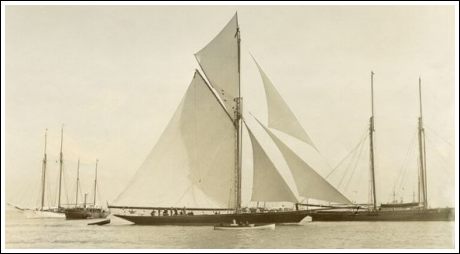
At 11:30 a keen-eyed amateur on the Talisman sighted a sloop away down the Bay, with her sheets trimmed flat aft, standing toward Coney Island on the starboard tack. He immediately proclaimed that the wind, which had strayed away like a prodigal, was now, like the old man from Norwich in the nursery rhyme, coming by the south. His prediction proved correct, and at 11:40 the air began to move slowly up the Bay.
THE WARNING GUN.
At 11:55 the Thistle hoisted her kedge aboard and got under way. The Volunteer at once followed suit, the two racers standing slowly up the Bay, with their sheets aft. And now ensued a trying period. Everyone could see that there was wind enough to start the yachts, and that their first work was going to be to windward; yet a number of tugs and steamboats would persist in staying on the line and just below it.

There was not a spot where either of the yachts could have got through the tangle of boats it they had received the signal, and as to their choosing where they would go, that was out of the question. The Electra whistled madly, but they paid no attention to her. Then the Patrol steamed through the fleet, and by dint of energetic whistling, shouting, and waving of hands succeeded finally in getting something like a clear space in which to start the racers.
And now every eye was fixed on the Electra. The preparatory signal was to be a gun, accompanied by hauling down of the United States ensign from the foremast head and the setting in its place of the blue peter. After this 10 minutes were to elapse before the starting signal, which was to be a gun accompanied by the hauling down of the blue peter and the setting of the New-York Yacht Club flag in its place. For a long time the Electra was silent. The Regatta Committee had evidently determined to give the starting signal on the even half hour, two hours after the time originally set down for the start. At last the preparatory gun boomed over the waters at 12:20.

At this moment the Volunteer was standing across the Bay above the line, heading westward, and the Thistle was just passing her going to the eastward. Both yachts were exactly north of the Electra when the gun was fired. The Thistle, as soon as she was well out from under the Volunteer's stern, tacked and ran down toward the Electra on the port tack. The Volunteer wore around slowly and stood up the Bay, with the wind on her starboard quarter. The Thistle rounded under her stern and followed her. Both were now together, with the wind on the starboard quarter, the Thistle to windward. They were a little to the north and west of the Electra, and were heading about northeast. The wind at this time was south-southeast and very light.
The Thistle walked past the Volunteer in a manner that brought dismay to the hearts of those patriotic Americans who old not notice that the Volunteer was away off the wind. A gun was accidentally exploded on the Electra, but as the blue peter was not hauled down the yachts knew that it was not the signal. They stood in across the Bay to the eastward. When above Buoy 18 the Thistle came about. At 12:28 the Volunteer hauled on the wind on the port tack on the east side of the channel and broke out her little jib topsail, which had been up in stops. She kept away immediately and ran across to the westward side of the channel. As the Thistle came across her bows she wore all the way round.
A MOMENT OF ANXIETY.
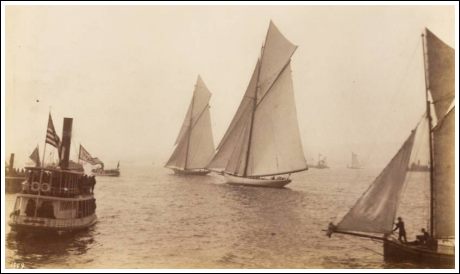
When the starting gun was fired, at 12:30, the Thistle was just in stays at the easterly side of the channel above the line, and the Volunteer, having jibed, was just crossing her stern. The Thistle filled away on the port tack and rushed toward the line, and the Volunteer, having stood out to get on her weather quarter, did likewise. Each boat had gone a little to windward of the buoy so as to come down with a good full on and luff close around the mark. This is precisely what they did, the Volunteer failing to get on the Thistle’s weather quarter because the latter was ahead, and was thus enabled to cross her bows.
The two yachts flew down toward the starting point in a beautiful manner, making astonishing speed in such a light air. They crossed in the following order:
Thistle ........ 12:33:06
Volunteer ...... 12:34:58½

After both yachts luffed around the buoy the Thistle had a lead of about 150 yards, and was pointed quite as high as she could be in order to have any headway at all. She went through the water with that some easy, sliding motion which has been noticed before in light winds. The Volunteer was pinched for a moment in a vain attempt to luff out across the Thistle's weather quarter. Gen. Paine and Capt. Haff at once saw that they could not make speed and point close enough for this trick, so they wisely gave the Volunteer her head. The moment they kept her away a little the steel sloop began to show her heels. It was the first time that a cup-hunting cutter had ever shown an American cup-hunting sloop such a lead across the line, and it made the Volunteer act like a scared prairie dog. Every eye was watching her keenly to are whether she was making any gain or not, and this was by all odds the most interesting moment of the day. Indeed it was the only moment of anxiety.
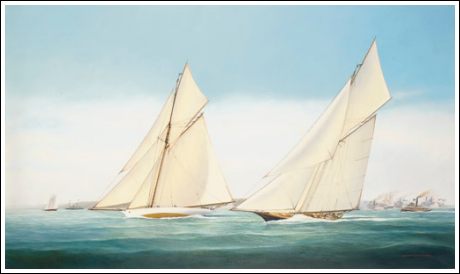
It was only a moment, though. At 12:39 the Thistle went about on the starboard tack and stood across toward the Long Island shore. It was evident that Capt. Barr expected that his antagonist, following the old maxim, “Stick to the boat you want to beat,”, would make the same move. The Volunteer, however, knew a trick worth two of that. 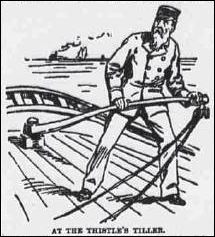 The flood tide was just beginning to make, and every old local salt knows that the ebb runs for some time longer under the Staten Island shore than it does in the middle of the Narrows. So the Volunteer just calmly held her port tack, heading toward the Quarantine wharf. Capt. Barr, seeing this, made up his mind that he would endeavor to follow the maxim about sticking to the boat he wanted to beat, and so at 12:41:25, before he had fairly gained headway on the starboard tack, he went back on the port tack. The flood tide was just beginning to make, and every old local salt knows that the ebb runs for some time longer under the Staten Island shore than it does in the middle of the Narrows. So the Volunteer just calmly held her port tack, heading toward the Quarantine wharf. Capt. Barr, seeing this, made up his mind that he would endeavor to follow the maxim about sticking to the boat he wanted to beat, and so at 12:41:25, before he had fairly gained headway on the starboard tack, he went back on the port tack.
But his fate was settled then and there, and in a very few minutes, even such poor salts as the steamboat Captains could see that the Volunteer was going to either cross the Thistle’s bows or, having the right of way, to force her about and come up on her weather quarter in the lead.
BOTH YACHTS BECALMED.

At 12:45 the Volunteer came about off Quarantine and reached out toward the center of the Bay on the starboard tack. If the Thistle had not tacked at 12:46:25 the Volunteer would have crossed her bows. The wind at the same time hauled somewhat more to the south, and the sloop got the advantage of it. The shift gave her a lead of nearly a quarter of a mile. Both yachts were becalmed under the lee of Staten Island, and the Thistle's head sails were hanging limp and lifeless.
The Volunteer, being ahead, caught the first breath of the wind over the Staten Island heights and began to move ahead, while the Thistle was in a flat calm. Both were on the starboard tack, the Volunteer about 300 yards ahead and 50 yards to windward. The wind was now south, half west, and very light indeed. The Volunteer got a good puff at 12:54 and begun to keel over. It did not last long, but it gave the steamers a chance to do some fearful whistling.
The Thistle was apparently anchored, and so the steamer Cygnus seized the opportunity to cross her bows and led several tugs in the same erring path. At 12:57 the Volunteer again caught a puff, and away she went on the starboard tack, heading toward Coney Island Point. The Thistle got the breeze two minutes later, but it was almost ahead of her, and she had to break off badly, not being able to head toward the Narrows, while the Volunteer was pointing straight out. The Volunteer passed out the Narrows at 1 o'clock. Fully 25 of the accompanying yachts were at this time to windward of the Thistle, but she was now beginning to move along in good style.  The Thistle passed through the Narrows at 1:08, three-quarters of a mile astern of the Volunteer. All this gain had been made in less than 25 minutes. The Volunteer passed the upper hospital island at 1:10. The Thistle passed through the Narrows at 1:08, three-quarters of a mile astern of the Volunteer. All this gain had been made in less than 25 minutes. The Volunteer passed the upper hospital island at 1:10.
The sloop was outpointing the cutter in a way that made every one stare. The steamboats broke all attempts at restraint, and a dozen tugs and other boats rushed right in ahead of the Thistle and gave her a most outrageous washing. She was treated with such scant courtesy that it would not be surprising if Mr. Bell made a serious objection to sailing again without some certainty of protection. The Volunteer, seeing the boats approaching her, hung out a big canvas sign over her lee quarter with heavy black letters reading "Keep astern." The tugs nearest to her answered with three whistles.
The Volunteer passed the lower quarantine island at 1:20. She was lying very close to the wind, which was now blowing enough to make her heel until her lee plankshear was not over a foot and a half above the water. The Thistle was pointing much further from the wind than the Volunteer, and seemed to be going at no greater speed. She was, of course, dropping to leeward all the time, and, as there was some windward work ahead of the yachts in getting to Buoy 10, the Volunteer certainly had a very commanding lead.
SCANT COURTESY FOR THE THISTLE.
The Thistle, which was three-quarters of a mile astern, was having insult added to injury by the constant running across her bows of tugs big, little, proud, and ugly. The Volunteer passed Coney Island Point at 1:25. The Thistle had not fallen astern any during the last 10 minutes, but she seemed at this time to be hopelessly out of the race. She was standing almost straight up and down and had very little wind. The breeze, however, took another fluke at this time and hauled a trifle more abroad on the weather bow of the boats and let them head a trifle better. This shift took the wind to southwest.
The Volunteer tacked at 1:33:25, half a mile northeast of Buoy 14, and stood directly across the channel toward the west side. When far enough up to weather Buoy 14 she tacked again, at 1:36:45, and stood to weather the buoy on the starboard tack. She passed the buoy at 1:39:15. The Thistle went on the port tack to get to windward of the buoy at 1:40:20. She stood well across toward the west side of the channel before tacking. She was bobbing about on the water a good deal, showing that there were plenty of little waves being kicked up by the tugs and steamboats that persistently passed and repassed her. The great majority of the fleet, however, was now up in the Volunteer's neighborhood, though most of them were pretty careful to keep out of her way. |
|

The Thistle tacked at 1:47:30, having run well up to windward of the Volunteer. She was unquestionably falling behind all the time and, so far as could be judged at this time, she could not by any possibility even get anywhere near the Volunteer again. She was a good mile and a half astern. At 1:50 the Thistle took in her jib and set a smaller one. She was so far astern that it was impossible to tell just what it was. The wind was so light now that everyone began to wonder whether the race could be finished in seven hours. If the breeze had not freshened it would not have been finished.
The wind now took another trick at boxing the compass and broke from southwest to due south. The Thistle held her southwesterly wind for some time and was enabled to get up somewhat on the Volunteer. Gen. Paine could not be caught napping, however, and at 1:59 he came about on the port tack and stood over to windward of his adversary, who was still a long way behind. It was more than three minutes before the shift of wind reached the Thistle and broke her off. She followed the Volunteer's example and made a very short board on the starboard tack and then, at 2:02:15, came about on the port tack.
The Thistle had gained nearly half a mile by the shifting of the wind. Just as soon as she got the same wind as the Volunteer it was plain to every unprejudiced observer that she could not begin to point with the sloop. The Volunteer passed Buoy 12 at 2:09.
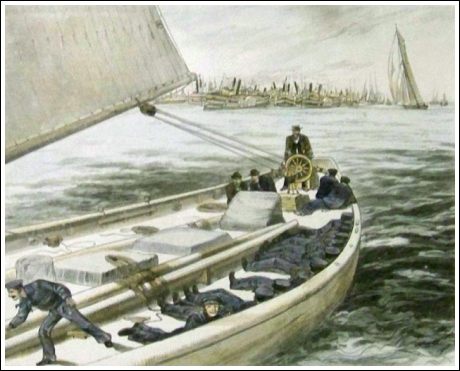
A MILE ASTERN.
The Thistle was a mile astern and far to leeward. The wind hauled once more and came in from the southeast. This was favorable to the Volunteer, as the Thistle had run well to the westward in the hope of getting to windward when the breeze was west of south. The Volunteer passed Buoy 10½ at 2:14:30. The Thistle was now a mile and a quarter dead to leeward.
The Volunteer passed Buoy 10 at 2:21:08. She held on her course on the port tack, and stood in toward the Highlands. She went on the starboard tack at 2:22:10, and stood for Buoy 8½, having just about enough room to weather it.
The Thistle was to leeward not only of the Volunteer, but of the entire fleet of accompanying steamers. No steamer Captain seemed to care a rap about how much discourtesy he showed her. Each one was bound to be near the leading yacht. The Volunteer passed Buoy 8½ at 2:27:10. The Thistle went about to stand for Buoy 10 at 2:59:30. The Thistle passed Buoy 10 at 2:36:45 on the starboard tack. She had hardly any wind at all, and there could be no doubt that the great fleet of boats between her and the Volunteer shut out a great deal of wind. The breeze eventually went back to southwest and stayed there. The cutter contrived to puss Buoy 8½ at 2:46:50, and the Volunteer passed Buoy 5 at 2:45:30, being over a mile and a half ahead of her.
FOLLOWING THE LEADER.
The great body of the accompanying fleet was now following the fortunes of the Volunteer. The steel sloop was going out past Sandy Hook and was beginning to feel the beneficial influence of the freshening breeze from the sea. She was reaping the benefit that is always gained by a long lead, for when a yacht is well ahead she gets all the good that comes of feeling the breeze first. She was heeling well over and her sails were all pulling like mustard plasters in a Summer mood. She was throwing a neat little fountain of foam from under her lee bow, and sending a small caldron of bubbles from under her stern.
Her speed increased materially as she got the freshening wind in her canvas and her lead over the Thistle, of course, grew every minute as she dropped Sandy Hook astern. This is one of the great faults of the New-York Yacht Club course. A yacht which is loading at Sandy Hook always increases her lead as soon as she gets outside that unattractive point of land.

The Thistle was toiling along astern with a very poor wind. Only a quarter of the great fleet of excursion boats waited to see her round the two buoys on Flynn's Knoll, for many were afraid that if they tarried they would not be able to catch the flying Volunteer again. The Thistle passed Buoy 5 at 3:02:45. The Volunteer had accomplished the bent from the start down to Buoy 10 in 1 hour 42 minutes 9¾ seconds, while the Thistle had taken 2 hours 3 minutes and 9 seconds to make the some distance. Thus the Volunteer beat her 21 minutes 29¼ seconds. In going from Buoy 10 to Buoy 5, which is off the point of the Hook, the Volunteer occupied 24 minutes 22 seconds, and the Thistle 26 minutes. Thus the sloop gained 1 minute 38 seconds by her good fortune in being ahead at this point.
When the Thistle had passed Buoy 5 she, too, began to get the benefit of the sea breeze, and she slid along in a creditable manner. It was, however, now altogether too late for her to have any hope of accomplishing anything in the race. She was hopelessly out of it, and the first struggle for the cup was turned into a lamentable stern chase. The old, old story was being repeated, and, if the truth must be told, even the most patriotic Americans “soured on it.” They went out to see a Thistle shaken by the wind—not by the Volunteer. They wanted a yacht race and they were getting a procession. It was extremely tame, and from this time out there was very little genuine interest in the race. 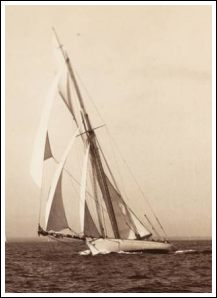 Americans who had, after the exercise of keen judgment on the Thistle's model, made up their minds that she was a very smart boat in light weather, had already drawn a long sigh of relief and had smiled the smile of serene content as they came to the conclusion that nothing short of a hurricane confined to the Thistle’s sails could enable her to catch the steel sloop. Americans who had, after the exercise of keen judgment on the Thistle's model, made up their minds that she was a very smart boat in light weather, had already drawn a long sigh of relief and had smiled the smile of serene content as they came to the conclusion that nothing short of a hurricane confined to the Thistle’s sails could enable her to catch the steel sloop.
The Volunteer had just enough wind to make her heel so as to chow the potlead that glistened, with a wicked gray glisten, along her shapely sides, and she slid through the water in a most industrious manner. She was so far ahead of the Thistle that the scene was absolutely comical, and to make it more amusing to all people who had no British affinities she continued to increase her lead. It was now simply a procession, and a very bad procession at that. No one could study the comparative merits of the two boats because they were so far apart. It looked as if the centreboard sloop had a decided monopoly of merits. She passed the South Channel Buoy, though well to the northward of it, at 3:10, and at 3:20 she went booming by the Scotland Lightship, two miles further on her course. This shows how she was walking through the water at this time.
The breeze gathered strength as the afternoon wore on. The Volunteer began to heel over until her lee rail was not far from the water, and her sails set as taut as drum heads. The whole fleet of steam vessels now hurried out to the Sandy Hook Lightship to wait for the rounding of the victorious "Boston bean pot.” The Thistle was all of three miles astern and was apparently still losing ground, or rather water.
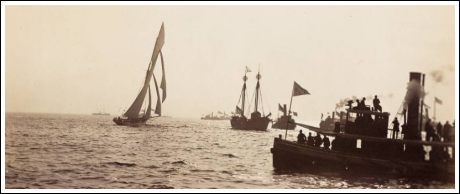
A large number of tugs and steamboats took up their positions near the lightship right in the Volunteer's path, and none of them seemed to have any idea of moving out of the way till they saw the sloop pointing right at them. Mr. Willard and two assistants were kept busy displaying the sloop's warning signs astern. Sometimes they stood up and held them, and at other times they sat down and bung them over the rail. The first boat that saw them would always obey them until she saw some other boat neglecting to notice them, and then she would follow suit. On the whole, though, they were of considerable assistance to the Volunteer.
ROUNDING THE LIGHTSHIP.
Volunteer a contourné le vieux vaisseau rouge Sandy Hook à 3:42:12 au milieu d'un tel vacarme de fusils et de sirènes comme on ne l'avait jamais entendu auparavant, même à cet endroit très perturbé.
![Volunteer turning S.H. [i.e. Sandy Hook] Lightship, Sept. 27, 1887 - John S. Johnston 01078S.jpg](/images/stories/1887/01078S.jpg)
The Volunteer rounded the old red Sandy Hook Lightship at 3:42:12 amid such a din of guns and whistles as was never before heard, even at that much disturbed spot. She had made the reach out from Buoy 10 in just 1 hour, 21 minutes, and 4 seconds. She was going at a splendid pace as she went around, for she had been gaining in speed ever since she left the Hook. If she had run the first three miles as fast as she did the latter part of the distance, she would have covered the ground in an hour. But there was not wind enough for any such display of speed yesterday. The distance from Buoy 10 to the lightship is a little less than 10 nautical miles.
Immediately after rounding the Lightship the Volunteer sent up her intermediate jib topsail in stops. She kept it up till 3:51, when she was just passing the Thistle as the latter was on her way to the outer mark, and then she broke it out. It was a very telling sail at this point of the race and pulled the Volunteer ahead in a beautiful manner.
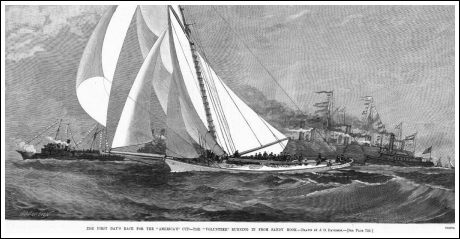
It was estimated at the moment of passing that the Volunteer was about three and a half miles ahead of the Thistle. The whole fleet of steam craft, which had gone out to see the sloop round the outer mark, was now rushing along to see her pass the Hook on her way in. Of course they churned the water into all kinds of cross seas and rips, and the Thistle had to suffer from this. Worse than that, a very large part of the fleet went to windward of her as she passed out, and hence she was constantly being partly blanketed. Her lower canvas was out of the wind a good deal of the time, and this, combined with the disturbed water, did her a great deal of serious harm.
She contrived, however, to round the lightship at 4:01:15. The Volunteer had made the run from Buoy 10 to the lightship in 1:21:04. The Thistle, in spite of drawbacks, accomplished the same distance in 1:24:30. The Volunteer, therefore, gained 3 minutes 26 seconds on her in this stretch. This was not very remarkable gain under the circumstances. Perhaps half of it was due to the interference of the steam fleet. The other half, however, was due to the fact that the Volunteer is the faster yacht.
The Volunteer passed the Scotland Lightship on her way in at 4 o'clock. She had set her balloon forestaysail a short time before this. It was now possible to see how much she was ahead of the Thistle, and there was no disputing the fact that her lead was saddening to all Scottish hearts. The two lightships are three miles apart, and the Volunteer, being about a quarter of a mile inside the inner one when the Thistle rounded the outer one, was unquestionably 3¼miles ahead. It was thought a dreadful thing to see her2 3-5 miles ahead of the Mayflower a few days ago, but the Thistle's people laughed over it, and hinted that there was another boat not far away that could do something of the same sort. Yesterday they found themselves worse off even than the Mayflower was.
The Volunteer, with her sails all drawing magnificently, but not heeling over at a great angle, continued to walk through the water like a thing of life. She was making no fuss about it, either. She out the water clearly and left it quiet behind her, while the Thistle, now that she was moving at a good speed, made it great fuss under her bows and did not leave the water nearly so quiet astern of her. The Volunteer passed Buoy 5 on her way in at 4:23:80. Her sheets were immediately hauled aft and for the first and only time in the whole race she came near putting her lee rail on a level with the water. She went like a frightened deer as she passed the point of Sandy Hook and she was a picture to delight the eyes of the admiring multitude.

She passed Buoy 8½ at 4:32:55 and, easing sheets again, rushed toward Buoy 10, at the same time lowering her spinnaker boom to starboard. And now the accompanying fleet began again to hug her, and she hung out a canvas sign bearing the brusque warning "Keep off !”. She jibed her mainsail and passed Buoy 10 at 4:36:15. She had, therefore, made the run in from the lightship with the wind on the port quarter in 54 minutes and 3 seconds. At 4:39:20 she set her spinnaker, hoisting it up to the masthead and sheeting it out instead of breaking it out of stops. As soon as this huge sheets of canvas was set and the Volunteer was fairly before the wind, she began to walk along in a splendid manner.
THE THISTLE’S SLIGHT GAIN.
The Thistle passed Buoy 5 at 4:40 and jibed around Buoy 10 at 4:52:47. She had accomplished the run in from the lightship in 51 minutes 32 seconds, gaining 2 minutes and 31 seconds on the Volunteer on this leg of the race. This was the only measurable gain she made on the Boston yacht in the course of the entire race, and she got the opportunity to make it because she was so far astern that there were no steam vessels around to bother her.
The steam craft were now bothering the Volunteer. Some ten or a dozen of them stretched in a line right across her wake, thus blanketing her lower canvas and depriving her of some of the wind which justly belonged to her. She passed the Galatea, on the way up, and Lieut. Henn waved his hat enthusiastically as he stood on the quarter deck of his pretty yacht. Every steamer that passed the Galatea saluted her and some of the excursionists cheered Mrs. Henn.
As soon as the Thistle had jibed around Buoy 10 she set her enormous silk spinnaker, which gleamed like frozen snow in the afternoon sun. She had profited by the freshening breeze outside the Hook, as well as by having open water, and she now seemed to be moving still faster than the Volunteer. She was all alone now, for even the Mohican had left her and run up near the Volunteer to see how she did it. The steam fleet must have done the sloop nearly as much damage at this part of the race as they did to the Thistle in the earlier part of the day, but it did not seem to prevent her from going along and approaching the goal of a fine gait.
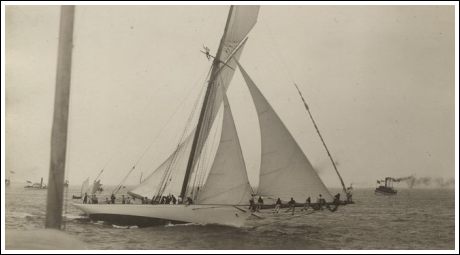
She passed Buoy 11 at 5:12, and was off the Lower Quarantine Island at 5:17. She was now nearing the finish, and the race was about at an end. The scene resembled that memorable day when the Puritan and Genesta were going on the same course. The wind was just about the same in direction and force. The two yachts came up the Lower Bay with spinnakers set, and the Genesta was away astern by herself, while the Puritan had a royal guard of honor in the shape of the grand fleet of accompanying yachts. And the Puritan beat the Genesta about the same time and the same distance. In fact, some of those who were looking at the race could not help calling to mind the old saying that history repeats itself.
The Volunteer passed the Upper Quarantine Island at 5:22, still moving through the water at a pretty pace. Around buoy 15, the finishing point, a forest of sails and masts had grown up in the last few minutes. There were all kinds of sailing craft, steam vessels, and rowboats gathered there to salute the victor.
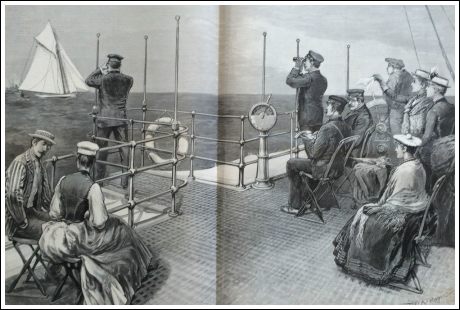
The Volunteer crossed the line amid the most deafening outburst of guns, whistles, and yells that ever broke loose this side of pandemonium at 5:28:16¼. She had made the run from Buoy 10 in 52 minutes 1¼ seconds. And now all hands waited patiently for the Thistle. She came along quite fast, her big spinnaker drawing splendidly, and crossed the line at 5:45:52¾, having made the run from Buoy 10 in 53 minutes 53 seconds. The Volunteer, therefore, gained on her in this race 1 minute 4½ seconds.
The result of the race is shown by the following table, the Volunteer allowing the Thistle five seconds:
| |
Start. |
Finish. |
Actual
Times. |
Corrected
Times. |
| |
H. |
M. |
S. |
H. |
M. |
S. |
H. |
M. |
S. |
H. |
M. |
S. |
| Volunteer |
12 |
34 |
58¼ |
5 |
28 |
16¼ |
4 |
53 |
18 |
4 |
53 |
18 |
| Thistle |
12 |
33 |
06 |
5 |
45 |
52¾ |
5 |
12 |
46¾ |
5 |
12 |
41¾ |
The Volunteer, therefore, in the first race for the cup, defeated the Thistle over the New-York Yacht Club's course of 38 nautical mile, 19 minutes 23¾ seconds, or a little over two miles and a half.
|
![Volunteer turning S.H. [i.e. Sandy Hook] Lightship, Sept. 27, 1887. - John S. Johnston 01078V.jpg](/images/stories/1887/01078V.jpg) THE VOLUNTEER'S VICTORY.
THE VOLUNTEER'S VICTORY.